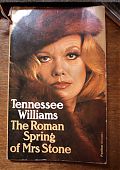
Tennessee Williams
The Roman Spring of Mrs. Stone
Notes on the novella:
Mrs. Stone, Karen Stone, was a famous actress whose career depended on her beauty. Time apprehended her with age, her husband died, she settled in Rome.
The Rome of Mrs. Stone was one of American tourists who stayed at the Excelsior hotel, who had plenty of money and little to do, like Mrs. Stone herself.
Loneliness: (or, as Williams calls it, “the drift”) Mrs. Stone’s marriage to Mr. Stone was one of loneliness. He emotionally supported her dizzyingly upward and successful career. But their relationship was like mother and son, sometimes switching the roles. There wasn’t any sex or physical anything.
The marriage of the Stones was haunted by a mysterious loneliness. All substitute relationships are haunted by something like that. The desiring fingers enclose a phantom object, the hungering lips are pressed to a ghostly mouth.
If Mrs. Stone was lonely in her marriage, then without her husband she is more so. (…she was at this time making the belated discovery that what she assumed was an ordinary attachment was actually a dependence of profound order.) Enter the Contessa and her young Paolo, who she delicately lays in the path of Mrs. Stone, as she had laid him in the path of other lonely women before her. Mrs. Stone advances to the bait…
Mrs. Stone is often compared to a predatory bird, both when she was young and now when she is older. The comparison illustrates her sharpness and ability to go straight to the mark, her skills at hovering and how she thinks of herself. Though she had not made much self-analysis when she was young and beautiful and swept up in her successful social and theatrical life, she is very honest about her self-discoveries once she does start, albeit too late.
Paolo: an indolent young Roman. Good-looking. In some ways, a reflection of Mrs. Stone in her youth. The self-centered rotation around an empty void of self. The reflection of Paolo is the shadowy young man who follows Mrs. Stone, who is so much more direct, as he’s not accustomed to the finery and fugues of richness.
Mrs. Stone knew what that sort of vacancy was, as well as anyone knows it. It was that sort of vacancy which permitted so many people of her acquaintance to lead the sort of lives they led without any evident consciousness of taking part in a vast ritual of nothingness… But Mr. Stone glanced inward from the peripheries of that circle and saw the void enclosed there. She saw the emptiness. She knew that it was empty. But Mrs. Stone was always a busy woman. She had been continually occupied with more things than a single existence seemed sufficient to hold, and for that reason, the way that centrifugal force prevents a whirling object from falling inward from its orbit, Mrs. Stone was removed for a long time from the void she circled.
Tennessee Williams describes Mrs. Stone as she ever approaches the center of the void of herself, her age, her looks and the onward sweep of time. Her behavior with Paolo becomes more and more hysterical as she attempts to grasp what she cannot. It is a strange and brilliant depiction that wavers between a very clear vision of Mrs. Stone and her actions, then converts into opacity.
As I read, I was in awe of Williams’ portrayal Paolo, his lustrous body. The care with which he wrote about the young man was not heterosexual and betrays that he had also worried along the lines of Mrs. Stone, and perhaps indulged in similar activities. His familiarity with the theatre no doubt means that he had seen women like Mrs. Stone who had to leave the stage, whose talents did not make up for faded looks.
In short, The Roman Spring of Mrs. Stone was a great read.
· · · · · · · · · · · · · · · · · · · ·